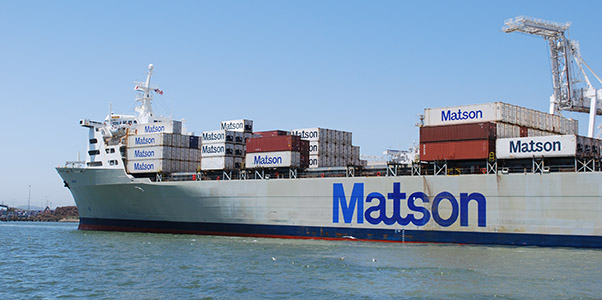Adhering to its initial positive forecast for 2014, Oakland-based Matson says its business performed as anticipated in the first quarter of 2014, driven by sustained demand in its core markets and continued freight rate.

Oakland-based Matson says its business performed as anticipated in the first quarter of 2014 and is positioned well to meet or surpass its financial performance from last year. Photo by Joel Williams
By Patrick Burnson
Published: June, 2014
Adhering to its initial positive forecast for 2014, Oakland-based Matson says its business performed as anticipated in the first quarter of 2014, driven by sustained demand in its core markets and continued freight rate.
“While the timing of fuel surcharge collections significantly impacted financial results during this past quarter, our businesses are running well and continue to generate substantial cash flow,” Matt Cox, Matson’s president and CEO, told investors.
“Coupled with our recent debt financing, we have ample capacity to fund our new-build vessel commitments, pursue growth opportunities and maintain a healthy dividend.”
As reported here late last year, Matson raised its rates for the company’s Hawaii service by $175 per westbound container and $85 per eastbound container for 2014.
“We continue to be encouraged by our prospects in Hawaii, and in a strengthening broader economy that will positively shape volume in our Jones Act trades and in logistics,” said Cox. “We expect modest improvement at SSAT and that our premium expedited service offering from China will continue to be in high demand. As a result, we are positioned well to meet or surpass our financial performance from last year.”
Matson believes that the Hawaii economy is in a multi-year recovery and anticipates modest market growth in the trade in 2014. However, a competitor is expected to launch new containership capacity into the trade in the fourth quarter of 2014, which could impact the company’s container volume.
In the China trade, overcapacity is expected to continue at least through 2014, with vessel deliveries outpacing demand growth. However, Matson expects to maintain its volume and average freight rates with high vessel utilization levels, as its expedited service continues to realize a premium to market rates. In Guam, muted growth is expected and Matson envisions its volume to be modestly better than 2013, assuming no new competitors enter the market.
Transpacific Lines Impose Surcharge Amid Surge in Bookings
Meanwhile, other transpacific container lines continue to experience a surge in eastbound bookings that began in January and is expected to continue into the second half of 2014, with vessel utilization in the mid-90 percent range via the West Coast and in the high-90 percent to full range to the East and Gulf Coasts.
To cover contingencies in the event of an earlier-than-usual peak season—diversifying port gateways, rerouting inland traffic, leasing extra equipment—member lines in the San Francisco-based Transpacific Stablization Agreement (TSA) have adopted a $400 per 40-foot container (FEU) peak season surcharge (PSS) for all shipments, effective June 15. Prior to the PSS, TSA carriers have recommended a guideline general rate increase (GRI) of $300 per FEU to the West Coast and $400 per FEU to all other U.S. destinations to further help offset rate erosion seen in recent months.
Both actions, TSA said, are separate from the group’s 2014-15 rate and cost recovery program for service contracts that are now being negotiated.
“Carriers continue to play catch-up on rates, which have been effectively stagnant since 2011,” said TSA Executive Administrator Brian Conrad. “Modest revenue gains from recent GRIs will not be adequate to pay for upgraded services to meet likely demand surges in the coming months.”
National Retail Foundation Urges Resolution of Looming Waterfront Labor Dispute
Negotiations now underway in San Francisco between the International Longshore and Warehouse Union (ILWU) and the Pacific Maritime Association (PMA) are being watched closely by the National Retail Federation (NRF).
In a letter sent to ILWU President Robert McEllrath and PMA Chairman and CEO James McKenna, the NRF pleaded the case for the sides to come to an agreement ahead of the June 30 contract deadline for West Coast dockworkers.
The letter was sent by more than 60 maritime and supply chain industry stakeholders, including manufacturers, farmers, wholesalers, retailers, distributors and transportation and logistics services providers.
“We urge you to make every possible attempt to conclude an agreement on a new contract before the current year expires on June 30,” the letter stated. “It is critical that a new agreement be reached without disruptions to the movement of freight.”
The letter also noted that failure to reach an agreement would have serious economy-wide impacts, with the potential for disruptions in the flow of commerce at West Coast ports creating uncertainty in a fragile economic climate and forcing shippers to develop contingency plans, which are costly in terms of jobs and economic competitiveness.
The letter also cited the 2002 West Coast work stoppage at ports, which caused an estimated $15 billion in reported losses and is not something all involved parties can go through again.


